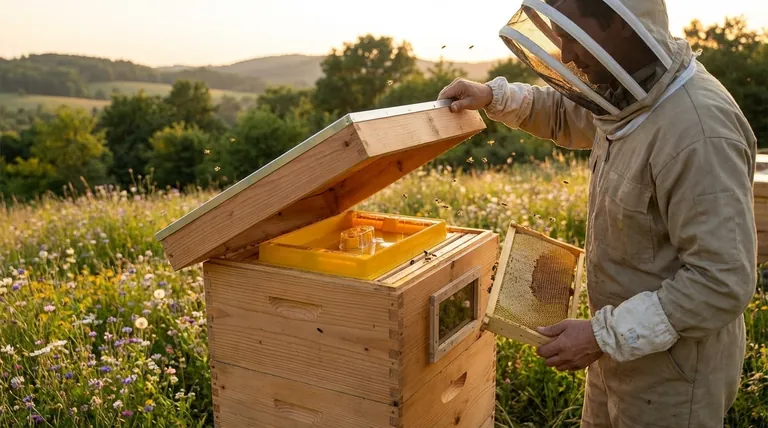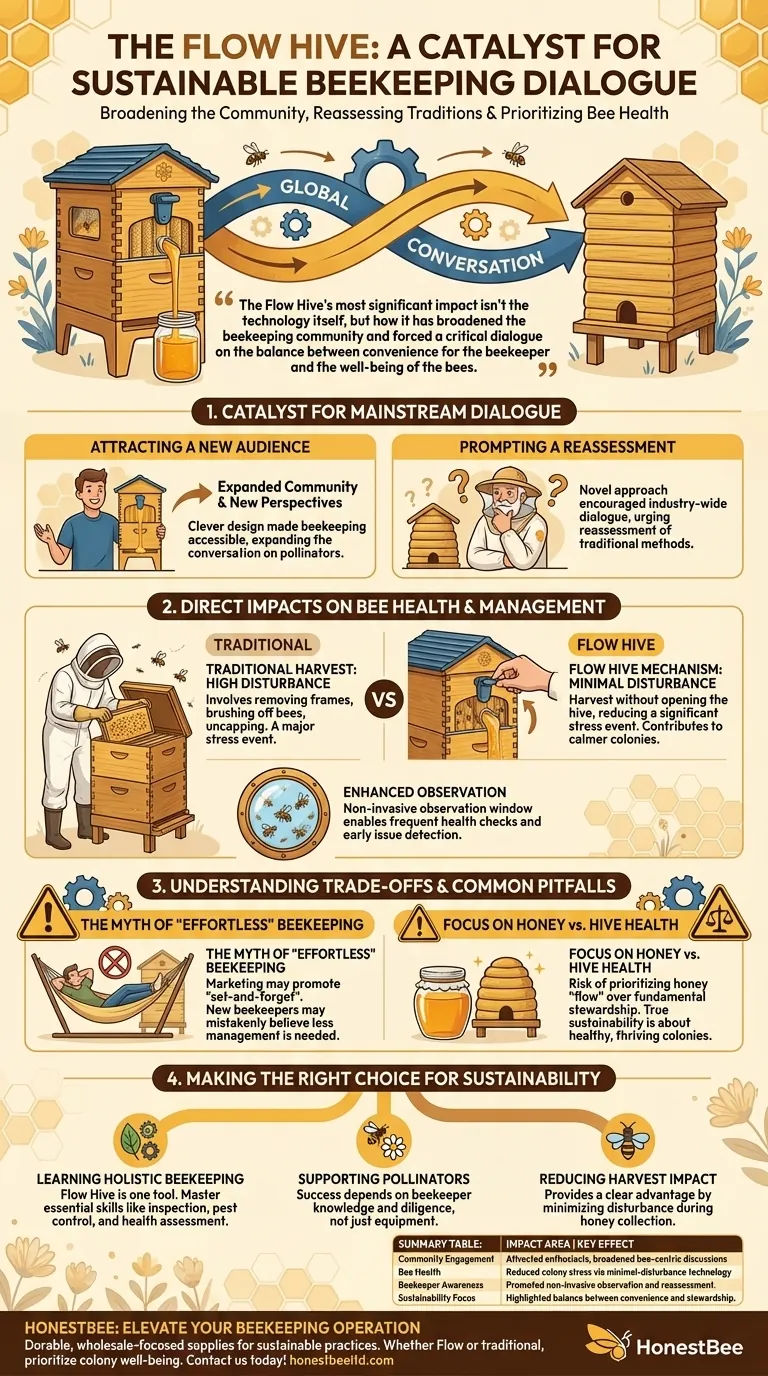In short, the Flow Hive has acted as a powerful catalyst. By attracting a new wave of enthusiasts and challenging long-held traditions, it has forced a global conversation about what truly constitutes sustainable, bee-centric beekeeping. It has compelled both novice and veteran beekeepers to re-examine practices, focusing discussions on bee health and the beekeeper's fundamental responsibilities.
The Flow Hive's most significant impact isn't the technology itself, but how it has broadened the beekeeping community and forced a critical dialogue on the balance between convenience for the beekeeper and the well-being of the bees.

A Catalyst for Mainstream Dialogue
The introduction of the Flow Hive did more than just offer a new way to harvest honey; it fundamentally changed the conversation around beekeeping. It brought the practice into the mainstream consciousness in an unprecedented way.
Attracting a New Audience
The clever design and promise of easy honey harvesting made beekeeping seem more accessible to people who might have otherwise been intimidated.
This influx of new interest has dramatically expanded the community and, with it, the conversation around bee health and our role in supporting pollinators.
Prompting a Reassessment of Practices
The Flow Hive's novel approach prompted many traditional beekeepers to articulate and defend their methods.
This created a healthy, industry-wide dialogue, encouraging everyone to reassess their practices and consider whether long-standing traditions were based on necessity or simple convention.
Direct Impacts on Bee Health and Management
Beyond the philosophical debates, the hive's design introduces specific changes to the management of a colony, with direct implications for bee health.
Reducing Harvest-Related Stress
Traditional honey extraction involves removing frames, brushing or blowing off thousands of bees, and uncapping the comb, all of which is a major disturbance to the colony.
The Flow Hive's mechanism allows for honey extraction with minimal disturbance, reducing a significant stress event for the bees. This can contribute to a calmer colony and better overall hive stability.
Enhancing Observation
A key feature of the Flow Hive is its observation window, which allows the beekeeper to see the bees at work without opening the hive.
This enables more frequent, non-invasive checks on the colony's activity and health, allowing beekeepers to spot potential issues sooner.
Understanding the Trade-offs and Common Pitfalls
The Flow Hive is a tool, and like any tool, its impact depends entirely on the person using it. Its greatest strengths can also lead to significant misconceptions.
The Myth of "Effortless" Beekeeping
The primary criticism leveled against the Flow Hive is that its marketing can promote the idea of "set-and-forget" beekeeping.
New beekeepers, attracted by the ease of harvesting, may mistakenly believe the hive requires less overall management.
The Focus on Honey vs. Hive Health
Successful beekeeping is about far more than harvesting honey. It requires regular inspections, pest and disease management, and ensuring the colony has adequate resources.
The risk is that a focus on the "flow" of honey distracts from the fundamental responsibilities of hive stewardship. True sustainability comes from a healthy, thriving colony, not from the volume of honey produced.
Making the Right Choice for Your Goal
The Flow Hive's role in sustainable beekeeping is ultimately defined by the beekeeper's commitment to learning and responsible management.
- If your primary focus is reducing harvest impact: The Flow Hive provides a clear advantage by minimizing disturbance and stress on the colony during honey collection.
- If your primary focus is learning holistic beekeeping: Treat the Flow Hive as one piece of equipment, ensuring you still master the essential skills of hive inspection, pest control, and colony health assessment.
- If your primary focus is supporting pollinators: Your success will depend on your knowledge and diligence as a beekeeper, not on the specific type of hive you choose.
Ultimately, sustainable beekeeping is determined by the actions of an educated and attentive beekeeper, not the equipment they use.
Summary Table:
| Impact Area | Key Effect of the Flow Hive |
|---|---|
| Community Engagement | Attracted new enthusiasts, broadening discussions on bee-centric practices. |
| Bee Health | Reduced colony stress during harvest via minimal-disturbance technology. |
| Beekeeper Awareness | Promoted non-invasive observation and critical reassessment of traditional methods. |
| Sustainability Focus | Highlighted the balance between convenience and fundamental hive stewardship. |
Ready to elevate your beekeeping operation with equipment that supports bee health and efficiency? At HONESTBEE, we supply commercial apiaries and beekeeping equipment distributors with durable, wholesale-focused supplies designed for sustainable practices. Whether you're managing Flow Hives or traditional setups, our products help you prioritize colony well-being. Contact us today to discuss how our solutions can enhance your beekeeping success!
Visual Guide

Related Products
- Professional Hive Top Bee Feeder for Beekeeping
- Professional Grade Foldable Beehive Handles
- Professional Hive Front Entrance Bee Feeder
- HONESTBEE Professional Hive Top Bee Feeder Feeding Solution
- Boardman Entrance Bee Feeder Durable Galvanized Steel and Wood Construction for Beekeeping
People Also Ask
- How to use a top feeder in a beehive? A Guide to Effective Beehive Feeding
- What are the features of top feeders for bees? Maximize Hive Health with Safe, High-Capacity Feeding
- What are the advantages of using top feeders for bees? Maximize Feeding Efficiency & Colony Safety
- Why is a top feeder essential for bees? Ensure Colony Health and Efficiency
- Do I need an inner cover with a hive top feeder? Optimize Your Hive Setup for Healthy Bees



















